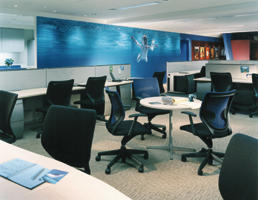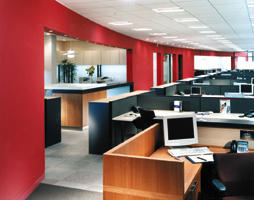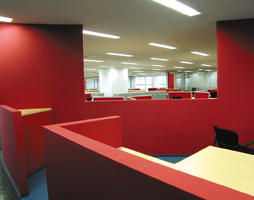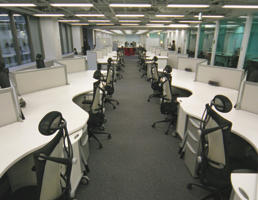Does Your Office Work for You?
Transforming your workplace into a profit center
by Dylan Robertson
In Tokyo, as elsewhere, satisfied workers are the most generous with their knowledge and expertise. People who love what they are doing and enjoy sharing their knowledge are the people who create the most economic value and, as a result, move their companies forward. The company must provide them with a workplace that supports their sharing of knowledge, helps expand their professional network, and, most importantly, encourages them to express genuine emotions, which strengthens bonds between team members and employees as a whole.
The Power of Professional Networks
Offices should be designed to reflect an organization's underlying social dynamics rather than its formal hierarchy. In an office, social relationships drive business forward, not the organizational chart. There must be a synergistic balance between the hierarchy of management and the informal social networks that really get things done. It is actually social networks that own the moneymaking "intellectual capital" within the organization.
The Company as Stage Manager
In order to transform the power of social networks into profits, the workplace experience must be emotionally engaging. The company must see itself as a stager of events and provider of an environment that releases the creative energy of its workers. When designing a workplace, the company should aim to theme the experience, harmonize impressions with positive cues, eliminate negative cues, and mix in memorabilia. When knowledge workers feel that management is helping them reach their full potential and values their contributions, they are motivated to give back to the company.
Less Is More
A better work environment does not necessarily mean using more space. By gathering comprehensive data about space use, managers can analyze current usage and plan to use space more effectively. Theoretically, many employers could reduce office space dramatically while still providing everyone with a place to work. In practice, the reinvestment of some of the potential savings into "unproductive" space -- relaxation areas, extra meeting rooms, staff facilities, etc. -- can boost staff motivation, and, in consequence, productivity.
Through strategic adoption of information and communications technology, successful companies are evolving different uses for office property. If employees are trained to make effective use of IT, electronic storage and communications can replace paper as the primary medium for most business processes. Flat screens and small profile PCs (coupled with paper-free working) can eliminate the need for large desks. Staff members will not need to come to the office as often if they are provided with mobile technology giving access to the necessary information and business applications from anywhere. Once these ideas are put into practice, exciting possibilities for innovative office design and significant savings in space open up.
All Desks Are Equal!
A new egalitarianism is permeating many forward-thinking companies. The idea is that the facilities are there to get the job done, rather than act as symbols for status, and this should determine the size, type and quality of the workspace. This approach also slashes the costs of moving people around or promoting them. Almost as emotive as the open-plan office is the "hot-desk," the idea being that all desks are equal. The number of desks equals the maximum number of staff at one time, which is usually far less than the total number. "Hot-desking" goes hand-in-hand with telecommuting and mobile working, enabling people to work in a wide range of locations. Good schemes involve staff at all levels and invest some of the space benefits of "hot-desking" in improving shared facilities -- café, meeting rooms, and resource centers.
This new egalitarianism is also evident in the blurring of intra-office functional lines; demarcation is outdated. Separate reception, booking, telephone, porter, post, security, and maintenance staff are fast giving way to a multi-skilled group whose members cover for one another, providing a single point of contact for all administration and support services. Secretaries are becoming team supporters, and are themselves working in teams to cover multiple groups.
The Value of Consultants
It is easy to become carried away in the property selection or design process when dealing directly with property owners or various vendors. This is where hiring a professional real estate consulting firm to assist in the process from start to finish will ensure that all options are considered.
Executives at successful businesses realize that hiring an outside consultant can enable them to realize their goal of creating a workplace environment that embraces a humanistic design philosophy, and balances the needs of brand, business objectives, and the people in the workplace. Such consultants target operational requirements to allow management to focus resources on business strategies, creating a cost-effective workplace based on quality management standards, benchmarking and key performance indicators - all functioning to meet the evolving demands of the company's core business. These consultants team with clients in a working partnership by collaborating to identify and implement strategic solutions to control costs, manage operational risk, leverage facility knowledge for better decision-making and create a safer, more productive working environment.
And don't forget the interior designer. He or she can guide you through the many choices in the office furniture market. Ergonomic chairs promote good posture -- as do desks and monitors of ideal height -- and give staff greater stamina.
With the right approach, the result is a perfectly harmonized integration of corporate image, flow, and function that motivates and inspires people and their business. JI
Please look at the case studies below.
*******
Dylan Robertson
Senior Associate, Office Services
CB Richard Ellis (Japan) K.K.
Tel. +81-3-6230-1141
Email: dylan.robertson@cbre.co.jp
Website: www.cbre.co.jp
Dylan Robertson is one of a handful of foreign real estate consultants with both advanced Japanese language skills and extensive experience in the Tokyo office market. He is the real estate advisor for a range of blue-chip multinationals.

When Universal Music decided to relocate its Tokyo facilities, the company contracted Gensler to develop a strategic planning concept to meet its evolving needs. The existing conditions had inhibited communications between team members and impeded innovaton. Over-sized murals throughout the new facilities serve as branding elements for each of its record labels. The new design has permitted Universal Music to revamp its Tokyo offices almost every year at minimal cost.

To sustain morale and productivity at Vodafone's Tokyo offices, its president retained Gensler, a highly reputed design firm, to create a working environment responsive to the needs of a global communications firm. Vodafone's signature red paint was used on major architectural walls as part of the internal branding.

A sexy work environment about an hour and a half by train from Tokyo? Bosch Rexroth wanted its new offices at its Tsuchiura factory to express more than functionality. Van der Architects dispelled the notion that work at a factory has to be dull and solemn by creating a refreshingly colorful, bright, wide-open space that is team oriented and fun.

When Ernst & Young Global Financial Services requested van der Architects to re-design its Tokyo office, a prerequisite was the creation of a funky work environment that would attract intelligent, vibrant, bright and energetic staff. The resulting design treats the office as a branding tool that says more than glossy company brochures. It is a space chock-a-block with high tech, designer furniture and lighting, custom artwork and unusual construction materials.





